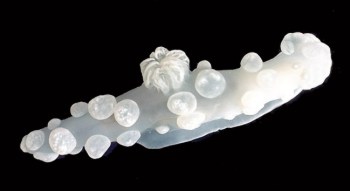
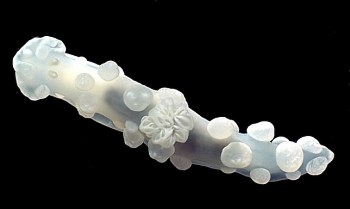
Gymnodoris sp. 5.
Order: NUDIBRANCHIA
Suborder: DORIDINA
Superfamily: ANADORIDOIDEA
Family: Gymnodorididae
DISTRIBUTION
Throughout tropical Indo-West Pacific. (Madagascar, Great Barrier Reef, Marshall Islands).
PHOTO
Two photos of an animal, 55mm long, from Osprey Reef, off Cairns, Nth.Queensland, December 1984. PHOTOS: I. Loch.
This white animal with large pustules, differs from all other gymnodorids in shape and colour.
Authorship detailsRudman, W.B., 1999 (October 24) Gymnodoris sp. 5. [In] Sea Slug Forum. Australian Museum, Sydney. Available from http://www.seaslugforum.net/find/gymnsp5
Related messages
Joy ride or dinner?
March 28, 2008
From: Gary Cobb
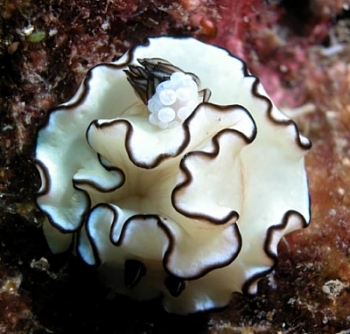
Concerning message #21011:
Hi Bill and everyone!
Well, while you are on the subject of hitch hikers ... here is Glossodoris atromarginata with Gymnodoris sp. My opinion is that the Gymnodoris is trying to get to its meaty heart and eat it. The Glossodoris seems to be in a position that seems to me to be in pain ... what do you thiink??
By the way, I did not see the Gymnodoris while in the water, only after reviewing the photos did I notice this happening!
Locality: Wait-a-while, Mooloolaba, Sunshine Coast, 14 m, Queensland, Australia, Pacific Ocean, 11 October 2003, Subtidal. Length: 10 mm. Photographer: Gary Cobb.
Cheers
Gary Cobb
gary@nudibranch.com.au
Cobb, G.C., 2008 (Mar 28) Joy ride or dinner?. [Message in] Sea Slug Forum. Australian Museum, Sydney. Available from http://www.seaslugforum.net/find/21075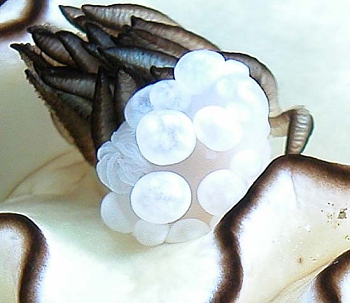
Dear Gary,
Thanks for your interesting photo. If I had a penny for every time someone sees something interesting in a photo for the first time I would be a rich man!
Your photo has an uncanny resemblance to Heidi Hösel's photo, which you refer to [#21011], of a Gymnodoris on Pectenodoris. The Gymnodoris in your photo is the one I have labelled Gymnodoris sp. 5. Concerning your theory of it eating the 'meaty' heart of the Glossodoris, I am afraid the heart of these animals is quite fragile. It essentially consists of a couple of layers of muscle fibres rather than a big block of muscle. I guess that as the blood is very thin and watery not a great effort is needed pump it around. I suspect if the Gymnodoris is eating, it is eating part of the body wall. Another possibility is that the Gymnodoris has just taken on an animal which is too big for it. I guess if they have an inbuilt instinct to bite or grab a potential prey item they can make mistakes.
If anyone has similar observations they would be very welcome. It is an interesting addition to the nudibranch feeding page.
Best wishes,
Bill Rudman
'White Wart' Nudibranch from Mozambique
June 25, 2002
From: Sean Sequeira
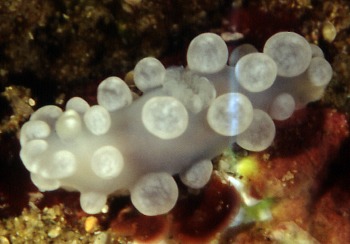
Dear Bill
This white wart nudibranch is a first!!!!! I took this picture at a reef called TEXAS in
Southern Mozambique. It was on a rock face covered with various coral species. The size was approximately 15mm long. I stayed with it for most of the dive, hoping the gills will "come out of hiding" but to no avail, my air ran out. Water temperature was 24 degrees. The depth was about 17 meters. After returning to the dive site the nudibranch had disappeared!
Regards
Sean Sequeira
westfax@netactive.co.za
Sequeira, S., 2002 (Jun 25) 'White Wart' Nudibranch from Mozambique. [Message in] Sea Slug Forum. Australian Museum, Sydney. Available from http://www.seaslugforum.net/find/7283Dear Sean,
This is a species I am calling Gymnodoris sp. 5 as it has not been named as yet - although I am working on that. You would have been waiting a while for its gills to come out any more because they don't expand much more than the liitle ring you can see in your photo.
Best wishes,
Bill Rudman
White Gymnodoris from S. Africa
September 22, 2000
From: Valda Fraser
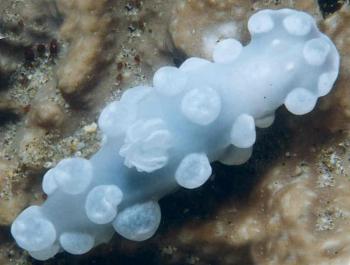
Dear Bill
I have found this nudibranch in a book - Gymnodoris sp. Has it been named yet?
Locality: Sodwana, north coast KwaZulu-Natal - 25m, SOUTH AFRICA
Date: August 2000
Size: 35mm
Regards
Valda Fraser
iti04937@mweb.co.za
Fraser, V., 2000 (Sep 22) White Gymnodoris from S. Africa. [Message in] Sea Slug Forum. Australian Museum, Sydney. Available from http://www.seaslugforum.net/find/2891Dear Valda,
I am getting there. I am trying to get a revision of the genus Gymnodoris finished by the end of the year. This white species is widespread throughout the Indo-West Pacific. The furthest west I have a rcord is from Madagascar, so South Africa completes the picture. It is Gymnodoris sp. 5 in the Forum.
Best wishes,
Bill Rudman.
A white species of Gymnodoris
October 25, 1999
From: Scott Johnson
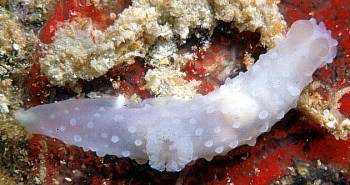
Hi Bill,
Here's a gymnodorid that doesn't follow the Orange Spotted Rule. These are always translucent white and covered with rounded warts. I've found them at Enewetak and Kwajalein in the Marshall Islands, usually crawling about on hard substrates on lagoon pinnacles at night. They ranged from 10 to 20mm and one in captivity tried to eat Hypselodoris maculosa and Dendrodoris nigra. It did not succeed, possibly because the prey were too large.
Scott
johnson@kmr.ll.mit.edu
Johnson, S., 1999 (Oct 25) A white species of Gymnodoris. [Message in] Sea Slug Forum. Australian Museum, Sydney. Available from http://www.seaslugforum.net/find/1288Thanks Scott,
It certainly breaks the orange colour rule. Nice to see it from the other end of the Pacific. I have records from Madagascar and tropical eastern Australia which suggests a wide Indo-West pacific distribution.
Bill Rudman.
